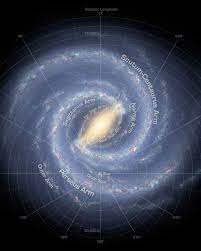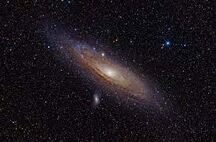A "galaxy" is a large collection of stars, often arranged into spiral arms in spiral galaxies, though elliptical, irregular, and lenticular galaxies have no spiral arm structure and instead are made directly of stellar belts. The total number of stars in a galaxy ranges from 100 trillion for giant elliptical galaxies to just 1000 in the tiniest dwarf galaxies. The Milky Way, a spiral galaxy, has 400 billion stars. Galaxies also contain spiral arms, which contain various solar systems. The Milky Way contains six spiral arms, though other galaxies can contain more or less, with a minimum of zero (in the case of spiral galaxies that retain only their central bar) and no real maximum. They contain multiple star systems. In addition to the properties above, galaxies are also organized into various groupings, such as local groups and super-clusters.
Etymology[]

Hera
Galaxy, from the Greek word ''γάλα'' which in English is translated to milk, actually means ''Milky Way''. Our own Galaxy is called Milky Way or Milky Way Galaxy as it is our own Galaxy. ''Galaxy'' basically means that milky circles around. In Greek mythology and religion, Zeus (Jupiter) placed his son, Hercules at the breasts of his wife, Hera (Juno) and Hercules drunk milky of Hera's breasts, but she realized it and woke up, Since she threw Hercules away from her chest, milky ''fell'' all around in the night sky, shaping the Milky Way, deriving the word ''Gala-Milk- Jias-Way''.
Galactic Classes[]
Elliptical Galaxy (E)[]
Elliptical galaxies are a type of galaxy that are round or oval in shape and are mostly made up of older stars; it is believed that many galaxy collisions end up creating elliptical galaxies, and that eventually they will become more common as the universe ages. They vary in size; dwarf elliptical galaxies can be made up of just a few million stars, while the largest of them can have trillions.
Elliptical galaxies are designated with the type En, with n equal to:

Our galaxy, the Milky Way
10 * (1 - a/b)
where a is the galaxy's major axis and b is its minor axis. In general, elliptical galaxies range from E0 to E7.
Well-known elliptical galaxies in our universe include IC 1101 (one of the largest known galaxies), M87, and Maffei 1.
Lenticular Galaxy (S0)[]
Lenticular galaxies are a type of galaxy taking the shape of a disc (like spiral galaxies) but which do not have enough active star formation to have spiral arms or a central bar. They tend to be made up of older stars, and their shape means that they are often compared to elliptical galaxies in structure.
Well-known lenticular galaxies in our universe include M84, the Cartwheel Galaxy, and NGC 4866.
Spiral Galaxy (Sa)[]

The Andromeda Galaxy, the nearest major galaxy to the Milky Way.
Spiral galaxies are a type of galaxy that are disc-like in shape but have their disc of stars spun into a set of spiral arms where there is a higher concentration of nebulae and large, bright stars. It is believed that stars will regularly "pile up" inside these arms like a traffic jam, and then leave the arm to travel to the next one. Like elliptical galaxies, they vary in size from millions of stars to trillions.
Spiral galaxies can be subdivided from Sa to Sc, with later letters indicating a looser and more diffuse spiral. The Sa subcategory is usually reserved for the tightest galaxies. Unfortunately, this Wikia does not seem to use this classification, with Sb being used for barred spirals (it is actually SBa through SBc).
Well-known spiral galaxies in our universe include M33, the Andromeda Galaxy, and the Milky Way.
Barred Spiral Galaxy (Sb)[]
Barred spiral galaxies are a type of galaxy similar to a spiral galaxy but possessing a central "bar" of bright stars near the core, to which the spiral arms are attached. Most spiral galaxies have bars, actually, but a "barred spiral" is usually used to refer to a galaxy with a more prominent and even bar. The creation of these bars is thought to be related to the same density wave that creates normal spiral arms.
Like normal spirals, barred spiral galaxies are subdivided from SBa to SBc based on how tightly wound they are.
Well-known barred spiral galaxies in our universe include NGC 1300 and the Milky Way (which appears to have a partial bar).
Loose Spiral Galaxy (Sc)[]
Loose spiral galaxies are a type of spiral galaxy, whose spiral arms appear to be "loose".
Whereas Sa and Sb galaxies have their spiral arms close and thin, Sc galaxies appear to have free-flowing, thicker arms and SBc galaxies have many thin arms.
SBa and SBb galaxies have arms that take a sharp turn, from going straight out and into a circular manner.
Irregular Spiral Galaxy (Sm)[]
Irregular spiral galaxies are galaxies that are irregular, which mean they aren't very symmetrical or "organized".
Irregular Galaxy (Irr)[]
Irregular galaxies are a type of galaxy, often very small, that have an irregular, nebula-like shape and no spiral arm structure. Many of them, like nebulae, are rich in stars, gas, and dust, while others are older spiral or elliptical galaxies that were perturbed by gravity into unusual shapes. There are two main types of irregular galaxies:
Irr I galaxies appear to have some structure, like a central bar or spiral arms, but are difficult to classify.
Irr II galaxies do not have any consistent structure.
Well-known irregular galaxies in our universe include the Small Magellanic Cloud, Leo A, and IC 10.
Dwarf Spherical Galaxy (dSph)[]
"Dwarf spherical galaxies" (also referred to as dwarf spheroidal galaxies) are among the smallest and most common type of galaxy. They are extremely small and faint, and only a few have been discovered in Earth's Local Group, but it is likely that most galaxies have several spheroidal companions. Many dwarf spheroidal galaxies resemble globular clusters, and distinguishing the two can be difficult.
Most of the Milky Way's and Andromeda (M31)'s companion galaxies are of this type.
Dwarf Elliptical Galaxy (dE)[]
Dwarf elliptical galaxies are the smaller counterpart of elliptical galaxies, being dwarf-sized and usually no more than a few kiloparsecs in diameter. They are similar to dwarf spherical galaxies in shape, but have distinct stellar formation patterns and age.
Well-known galaxies of this type in our universe include M32, NGC 147, and NGC 185.
Dwarf Irregular Galaxy (dIrr)[]
Some of the smallest of all galaxy types, dwarf irregular galaxies (dIrr) are very loose and small galaxies containing as few as a couple thousand stars, putting them very close to globular clusters. They are known to have low metallicity, meaning they are good indicators as to what the universe was like when it formed.
While somewhat common as satellites around larger spiral or elliptical galaxies, they are difficult to separate in classification from normal irregular galaxies.
A few dwarf irregular galaxies in our universe include UGC 4459 and the Canis Major Dwarf.
| Galaxies Types |
|---|
| Galaxy Types
Wrong Type · Spiral · Elliptical · Lenticular · Nebula |
